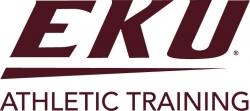History of Athletic Training at EKU: Part 2 - From Undergrad to Graduate ATs
The use of undergraduate students as athletic trainers wouldn’t last forever. The National Athletic Trainers’ Association was formed in 1950 and with that momentous step the profession began to grow and develop. As the profession developed and full-time athletic trainers became more prevalent in higher level settings, such as professional and universities, athletic training at EKU evolved as well. Though Eastern Kentucky State College (later to become EKU) was not ready to hire a full-time AT, the foundation for hiring a graduate student with experience was set. In 1960, the head athletic trainer at the University of Kentucky, Rusty Payne, provided insight on establishing a position for a graduate student and the current athletic director at EKU, Turkey Hughes, created a position.
Chris Patrick was to become the first head athletic trainer as a graduate assistant from 1961-62. He graduated with a bachelor’s degree from the University of Tennessee where he had gained two years of experience as a student athletic trainer under the teaching of a full-time athletic trainer. After a short stint in the US Army, he was hired to work as an AT at EKU.
In these early years of athletic training, professional training was handed down clinician to student and experience became learning. Despite two years as an athletic training student aide, there was no formal education process, no continuing education, and worse, no medical team to work with. In treating patients, he relied on good judgement and experience he had. This led to some experimentation and these new experiences continued to mold his clinical practice. As a graduate student, he was responsible for 1 student athletic training aide and 2 sports with very little if any budget. Equipment was lacking and he states his greatest learning outcome while at EKU was developing the skill to improvise.
Chris Patrick, began to establish athletic training at EKU. During his time at EKU he was hired to work primarily with football, however, he was able to gain the trust and respect of other coaches and soon was covering basketball as well. Coach McBrayer, the head basketball coach at EKU during that time, saw the benefit of the athletic trainer and convinced Chris Patrick to work basketball for an additional $50/month. These connections helped to show the need for athletic trainers working with all sports that would soon lead to the hiring of athletic trainers with more experience in full-time positions to cover all sports across campus.
Eventually, Chris Patrick’s time at EKU would end since he was a graduate student and the full-time position wasn’t open at that time. After leaving EKU, Chris Patrick would continue an illustrious career that found him working at the high school setting, several collegiate settings ending with 2 years at the University of Kentucky and then 48 at the University of Florida where he still has an office today. He was able to take his experience, innovating with patient care and defining the roles of athletic trainers, and joined a committee of six individuals to draft the first certification exam. He continually contributed to the profession as a part of many committees at the district and national levels, leaving a legacy that helped to define standards for the athletic training profession.
Chris Patrick was one of many “firsts” in athletic training at EKU and he would be succeeded by Leroy Mullins. Leroy Mullins would continue to strengthen the foundations of athletic training at EKU and continue to mold the view of athletic trainers on campus. His motto was “an ounce of prevention is worth a pound of cure”.3 His days consisted of treatments at 7:30am and practice preparation at 1pm. After practice he would leave the athletic training facility around 7:30pm just to return for a final round of treatments at 10pm. Rinse and repeat.
In between, he would go to class, study, record treatments, and communicate with coaches. By the end of Leroy’s short tenure at EKU, the institution would be ready for a full-time athletic trainer and he would be ready to continue his career, gaining many awards and recognitions at the district and national levels of the profession.
References:
1Patrick C. (2018). Interview, Oral Communication.
2Barton R. (2017). Interview, Oral Communication.
3Daugherty S. (1965). ‘Ounce of Prevention’ Marks Leroy Mullins, Trainer. Eastern Progress, p.5.
Contact Information
Matthew J Sabin
matthew.sabin@eku.edu
859.622.8149
Published on June 07, 2018
